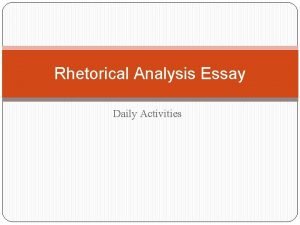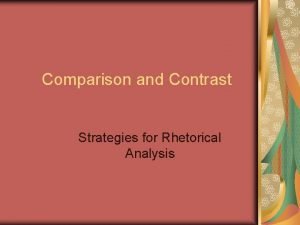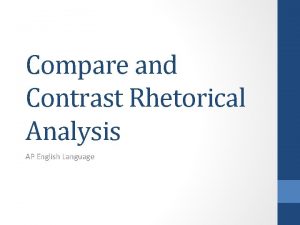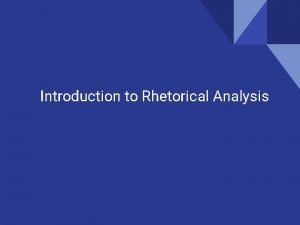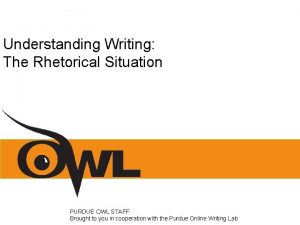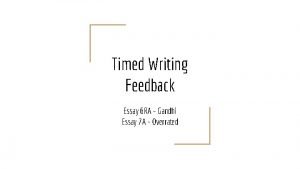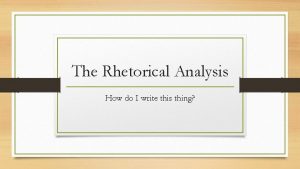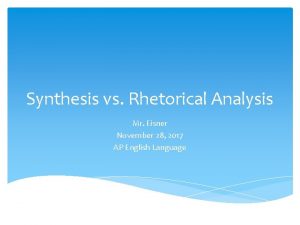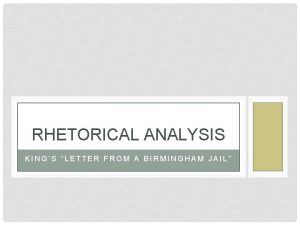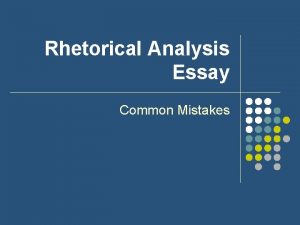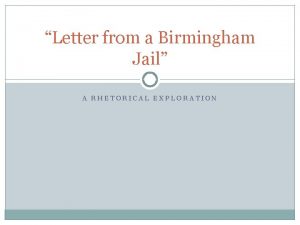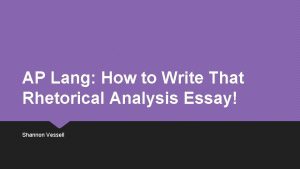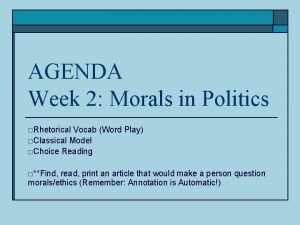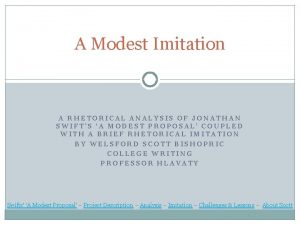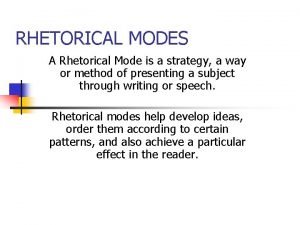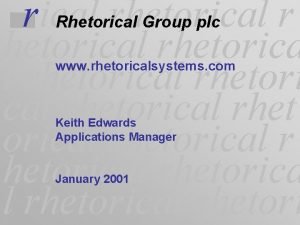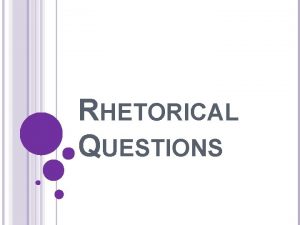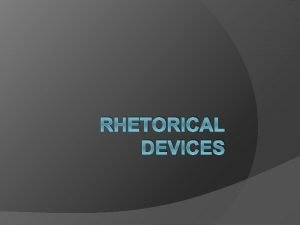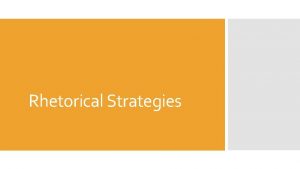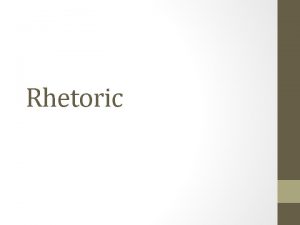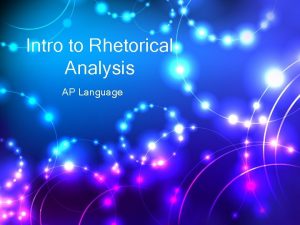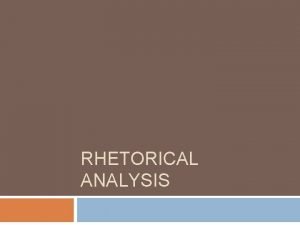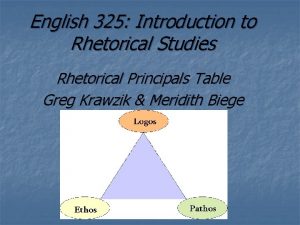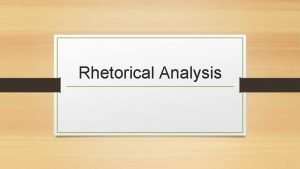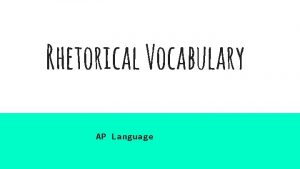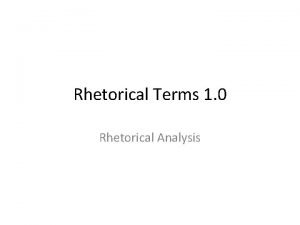Introduction to Rhetorical Analysis AP English Language and





















- Slides: 21

Introduction to Rhetorical Analysis

AP English Language and Composition “An invitation to the conversation among educated adults. ”

Overview of the APELC Test SECTION ONE � Multiple Choice � 60 Minutes � 50 -60 Questions � 45% of your total score SECTION TWO � THREE Essay Responses � 120 minutes (40 min/each) � Q 1 - Synthesis � Q 2 - Rhetorical Analysis � Q 3 - Argument � 55 % of your total score

Rhetoric and Rhetorical Reading ● A good grasp of rhetoric makes “good citizen”; a good citizen is an “informed citizen. ” ● Rhetoric by definition: Language that is used to influence people. ● Analytical reading is something thoughtful people do every day. • Analysis: How the parts work together to achieve the meanings, purpose, and effects. • What do you think the “parts” are? 4

Important “When people read rhetorically… when they engage in rhetorical analysis, they not only react to the message, but they appreciate how the producer of that message is conveying the message to a particular audience too, whether that intended audience includes the analyst or not. ” --Jack Selzer 5

Stop and chat… • Discuss with your partner: What do you think you will do when you write a Rhetorical Analysis in this class?

Reading Rhetorically • All authors have a purpose for writing. ○ To make readers things their way/adopt their point of view. ○ Change a reader’s understanding of the subject. • Rhetorical readers maintain distance from the text and carefully consider author’s perspective. It’s not always about you.

Reading Rhetorically • Rhetorical Analysis is analysis of what the author is saying and the techniques he is using to advance his ideas and affect his audience. • WHAT author says+HOW he says it=influence on audience or reader.

Rhetorical Triangle ● Analyze to be able to understand text. 9

What is it good for? • One way to consider the elements of a text/speech • The interaction between subject (message), communicator (speaker, writer), and audience (listener, reader) • The interaction of these elements determines the structure and language of the argument (the text/image that establishes a position) • Skilled communicators first choose a subject and then evaluate: what they know about it, what others have said about it, and what evidence/proof will help develop an effective position

Rhetorical Triangle ● Audience: For whom is this being written? Why? ● Persona: The “mask” the writer adopts to deliver the message. ● Purpose: Why is this being written? What is the writer’s goal? ● Subject: What is the writer writing about? Why? ● Context: What is the situation surrounding the writing? What is giving the writer a reason to deliver this message? ● Genre: What form is the message taking? 11

The Communicator (Speaker/ Writer) • Need to identify the speaker- not as easy as it may sound • Often assume a persona- the character that the speaker/writer creates which depends on the context, purpose, subject, and audience – Poet – Comedian – Scholar – Expert or novice – Critic – Concerned citizen

The Audience • Each audience requires the writer/speaker to use different information and devices to present their argument effectively. • Audiences can be primary/secondary, intended/unintended • Consider the difference between: – Essay for college application – Letter to a prospective employer – Letter to a newspaper about an newly-proposed policy by an elected official • Consider audiences who are “differently situated” – Politically, economically, socially (education, gender), culturally (ethnicity), geographically, etc.

The Audience • Questions to consider: – What are the audiences: ■ Knowledge? ■ Feelings? ■ Values? ■ Beliefs? – Is their common ground between the writer’s and reader’s views on the subject? ■ Empathetic ■ Sympathetic ■ Antithetic ■ Apathetic

Stop and write. . . ● In your notebook, label the rhetorical triangle for the John Mc. Cain letter.

The Rhetorical Situation ● Every text lives in a rhetorical situation. ● Exigence: What were the circumstances surrounding the original delivery and/or publication of the piece? (Context/occasion) ● Audience: For whom was the piece written? ● Purpose: Why did the author write the essay/speech/work? 16

Stop and chat… ● What is the rhetorical situation for the John Mc. Cain letter?

Surface features of a text • L. I. D. D. S. • “Put on your thinking cap” 18

Features of a text (L. I. D. D. S. ) • Language (figurative): Metaphor, simile, personification, schemes, tropes, etc. • Imagery: What sensation is the writer exploiting? • Details: What examples and details does the writer include? Omit? • Diction: Word choice. Why does the writer use specific words? • Syntax: Sentence structure—What does the sentence structure reveal about what the writer thinks/wants to emphasize? 19

Stop and write. . . ● In your notebook, analyze L. I. D. D. S. in the Mc. Cain letter

Summary Time Review your notes and then…turn to your table peep and: • Tell that person three things you did not know before this presentation began. • Ask two questions you have about what we just learned. 21
 In praise of a humble comma summary
In praise of a humble comma summary Compare and contrast rhetorical analysis
Compare and contrast rhetorical analysis Compare and contrast rhetorical analysis essay example
Compare and contrast rhetorical analysis essay example Exigence ap lang
Exigence ap lang A level english language language change
A level english language language change Is anaphora ethos pathos or logos
Is anaphora ethos pathos or logos Rhetorical analysis thesis example
Rhetorical analysis thesis example Purdue owl rhetorical analysis
Purdue owl rhetorical analysis Gandhi rhetorical analysis
Gandhi rhetorical analysis Rhetorical analysis thesis
Rhetorical analysis thesis Synthesis vs argumentative essay
Synthesis vs argumentative essay Soapstone purpose example
Soapstone purpose example Rhetorical analysis of letter from birmingham jail
Rhetorical analysis of letter from birmingham jail Transitions for rhetorical analysis
Transitions for rhetorical analysis Rhetorical analysis hook example
Rhetorical analysis hook example Owls by mary oliver
Owls by mary oliver Syllogism in letter from birmingham jail
Syllogism in letter from birmingham jail Examples of choices in spacecat
Examples of choices in spacecat How to write rhetorical analysis essay ap lang
How to write rhetorical analysis essay ap lang Not by math alone rhetorical analysis essay
Not by math alone rhetorical analysis essay A modest proposal rhetorical appeals
A modest proposal rhetorical appeals Rhetorical modes
Rhetorical modes
